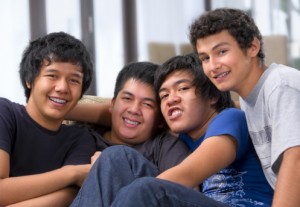 Numerous studies have pointed out the correlation between adolescent delinquency and negative peer pressures. But do positive peer associations also impact adolescent behavior? In a recent issue of the journal Children & Schools, published by NASW Press, Amy C. Traylor, PhD, Javonda D. Williams, PhD, Jennifer L. Kenney, PhD, and Laura M. Hopson, PhD, outline their findings on a study of adolescents among peers with prosocial behaviors.
Numerous studies have pointed out the correlation between adolescent delinquency and negative peer pressures. But do positive peer associations also impact adolescent behavior? In a recent issue of the journal Children & Schools, published by NASW Press, Amy C. Traylor, PhD, Javonda D. Williams, PhD, Jennifer L. Kenney, PhD, and Laura M. Hopson, PhD, outline their findings on a study of adolescents among peers with prosocial behaviors.
Specifically, their study examined friend support and behavior, assessing for interdependent relationships with adolescent behavior and well-being. Keeping with an ecological framework, relationships were examined in the context of other risk and protective factors in youths’ homes, neighborhoods, and schools. They used data from the School Success Profile, which was developed by Dr. Gary L. Bowen, School of Social Work at the University of North Carolina at Chapel Hill. This reliable and valid measure consists of 220 items, and assesses strengths and needs in students’ peer groups, families, schools, and neighborhoods. The data set includes data compiled between 2001 and 2005 from 37,354 students who attended 318 middle and high schools in seven states.
Here are some of their findings:
- Students with more support from friends reported better behavior than students with less support. Students also reported better behavior if they had friends who were engaged in positive behaviors. On the other hand, the relationship between student behavior and support from friends does not appear to depend on whether those friends are engaged in problem behaviors.
- Student race or ethnicity was related to well-being, with African American students reporting better well-being and white students reporting lower well-being than students from other racial and ethnic backgrounds.
- Students from low-income families tended to report lower well-being
- Living with two parents was not associated with well-being; however, more parental support and higher expectations were associated with better well-being.
- Students who reported more support from friends reported better well-being. Having friends with fewer problem behaviors was also related to better well-being.
Significantly, for the purposes of the study, all students reported better well-being if they had friends with better behavior. Among the group with the most supportive friends, there was a stronger relationship between friend behavior and well-being than for the other groups. Thus, the evidence supports the importance of both friend support and friend behavior and suggests that the combination of the two amplified the strength of their relationship with well-being. It is also noteworthy that students with low levels of support from prosocial friends reported better well-being than students with high levels of support from friends with more problem behaviors.
The authors conclude:
[These] findings have implications for service delivery and professional development for those working with children in schools. Given that African American, Hispanic, and white students may place differing levels of importance on home, neighborhood, school, and peer group supports, there is a strong need for holistic assessment of students’ support networks. This process requires school professionals, including teachers, counselors, and social workers, to work in interdisciplinary teams to develop resources and interventions that fit the needs of each student. School social workers are important members of these teams, as they are trained to conduct ecological assessment of supports and stressors in students’ homes, neighborhoods, peer groups, and schools. They are also trained to apply ecological understanding in their interventions by engaging important individuals in the adolescent’s environment. This means being open to including parents, teachers, peers, and other individuals who influence an adolescent’s well-being in treatment planning. Including these key individuals in interventions with adolescents is likely to have a greater impact than working with a student alone. Even research-based family interventions may fail to improve outcomes if they neglect to engage students’ peers, who become increasingly important influences during adolescence.
They also suggest that further research is warranted, so that social workers will have the appropriate tools to assess and develop students’ sense of wellbeing and positive behavior.



